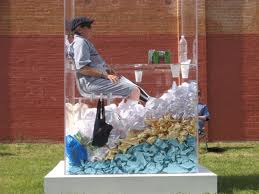 Probably since the time in 1962 Yves Klein traded “immaterial space” for gold leaf – and then threw lots of that gold leaf into the Seine – performance art has inspired controversy, of one form or another. Think even of Marina Abramovic’s The Artist is Present at MoMA two years ago, which was probably the most wildly acclaimed part of her wildly acclaimed retrospective: all she did was sit in a chair, and so what. And yet, many people came and sat opposite her, and stared at her, and cried. Cried! Which kind of makes you think – is this the sort of thing that would happen automatically if we sat staring at one another, not necessarily an eminent conceptual artist, just two people, staring at each other for awhile, motionless, without speaking, without expression – would we cry, as well, and does that mean that an unblinking human gaze somehow inherently causes us to want to cry? And how are the people that sat and cried different from the people that sat and didn’t? The stimulus didn’t change, after all.
Probably since the time in 1962 Yves Klein traded “immaterial space” for gold leaf – and then threw lots of that gold leaf into the Seine – performance art has inspired controversy, of one form or another. Think even of Marina Abramovic’s The Artist is Present at MoMA two years ago, which was probably the most wildly acclaimed part of her wildly acclaimed retrospective: all she did was sit in a chair, and so what. And yet, many people came and sat opposite her, and stared at her, and cried. Cried! Which kind of makes you think – is this the sort of thing that would happen automatically if we sat staring at one another, not necessarily an eminent conceptual artist, just two people, staring at each other for awhile, motionless, without speaking, without expression – would we cry, as well, and does that mean that an unblinking human gaze somehow inherently causes us to want to cry? And how are the people that sat and cried different from the people that sat and didn’t? The stimulus didn’t change, after all.
This is what is good and intriguing about performance art: it causes us to ask these questions. Last weekend, a Dallas artist named Erica Felicella sat in a Plexiglass box, about the size of a phone booth, for forty-eight hours, writing a single sentence over and over again on hundreds of sheets of paper. Whatever it might have meant (isolation? prison? the futility of communication in the modern world? etc. etc.) was ultimately far less important than what it did, which was: brought people together, to a vacant lot behind the Kessler Theater, and got them talking. (FULL ARTICLE: Stephen Becker, Art & Seek)
